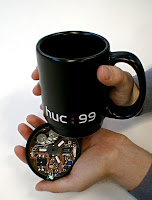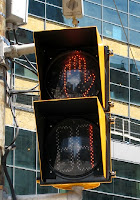Today I was reminded of a discussion in 1998 on the implications of computing technologies becoming cheaper and cheaper. Even then it seemed inevitable that many artifacts will include computational and perceptual qualities. The discussion was in the context of the European project TEA (technology for enabling awareness) where we built a context-aware phone [1]. Walter van de Velde suggested imagining that processors, sensors, communication will only cost cents (or will be virtually free as part of the production process) and we worked on the question: what products and services will emerge? One generic answer then was than any product of a value 20$ and above will include computing and sensing capabilities, if there is any (even a minimal) advantage achieved by this.
Michael Beigl made it more concrete and found coffee mugs (which were more than 20$ each) and attached a processor, communication and sensors. The MediaCup [2] showed several interesting results and underlined that such approach makes sense if there is an advantage.
Today I saw in an office of a former colleague in Munich two objects that had perceptual qualities and output (not really processing yet). One object is a plastic toad that makes a noise when you move and the other is a rubber pig that makes a noise when you open the fridge (reacts on change in level, but did not work). This made me wonder if we were only partially right – yes objects will have sensors included, yes there will be processing, but no there is no need that it makes sense. Or perhaps having it as a gadget is advantage enough…
[1] Schmidt, A., Aidoo, K. A., Takaluoma, A., Tuomela, U., Laerhoven, K. V., and Velde, W. V. 1999. Advanced Interaction in Context. In Proceedings of the 1st international Symposium on Handheld and Ubiquitous Computing (Karlsruhe, Germany, September 27 – 29, 1999). H. Gellersen, Ed. Lecture Notes In Computer Science, vol. 1707. Springer-Verlag, London, 89-101. DOI= http://dx.doi.org/10.1007/3-540-48157-5_10
[2] Gellersen, H. W., Schmidt, A., and Beigl, M. 2002. Multi-sensor context-awareness in mobile devices and smart artifacts. Mob. Netw. Appl. 7, 5 (Oct. 2002), 341-351. DOI= http://dx.doi.org/10.1023/A:1016587515822





